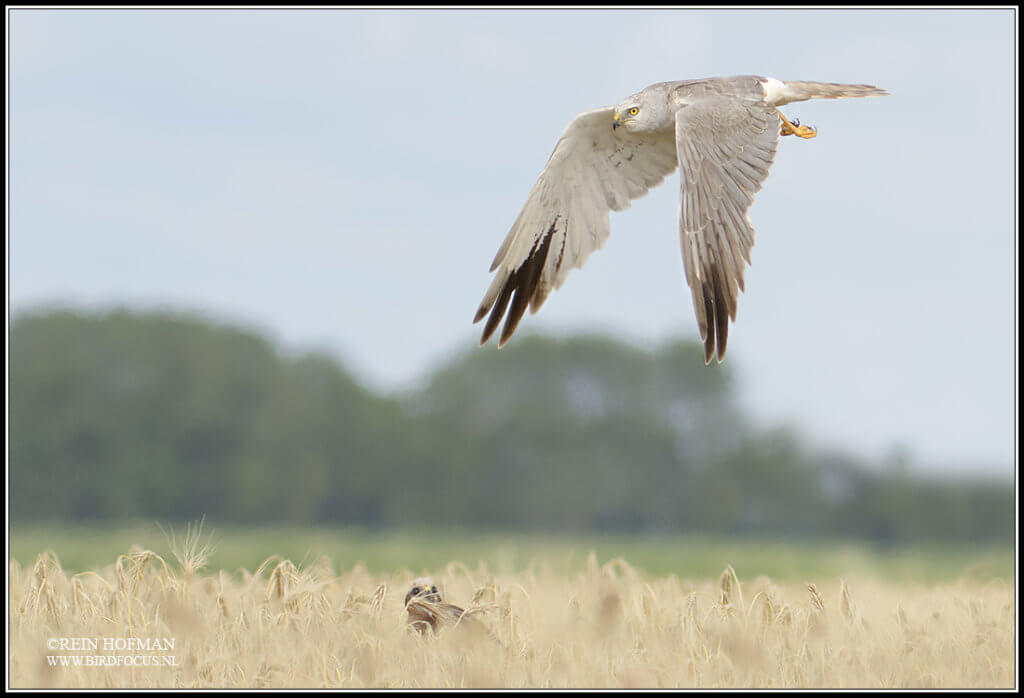
The first nesting of Pallid Harriers in western Europe has occurred in the Netherlands this year, and the birds have fledged four young (all females). The birds were discovered by Willem-Pier Vellinga, a volunteer of the Dutch Montagu’s Harrier Foundation. This successful nesting of a rare species is only now being publicised at the end of the season and went unnoticed by the Dutch birding community because it occurred on standard arable farmland.
Video courtesy of RJ van der Leij/Ruben Smit Productions.nl
Chronology:
Vellinga discovered the male Pallid Harrier by chance while doing breeding bird counts in May (UK birders please note – sign up for a BBS square!) and it appeared to him that the bird showed breeding bird behaviour. Together with harrier expert Ben Koks the following day the breeding location was located in a parcel of winter barley.
The first egg was estimated to have been laid between 8 and 10 May.
A nest protection fence was put in place on 17 June. At that moment, five chicks of between three and eleven days old were in the nest. Without nest protection the chance of predation by beech marten or fox, that could hear the racket of the young, would have been high.
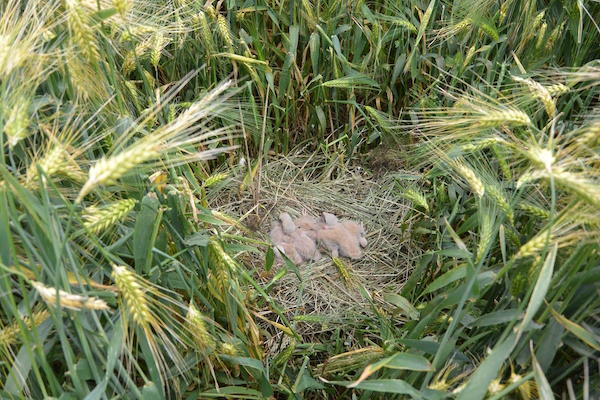
Besides protection from predation it was important to preserve the nest from the wind. With heavy rains and strong winds barley tends to tilt over and may bury the nest and its residents, the end of the breeding attempt. This was a real risk when wind and rain hit the fields of Groningen on 9 June.
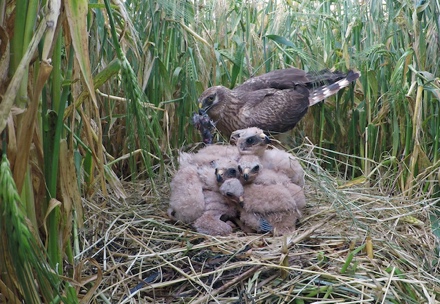
The winter barley was harvested in early July. Staff and volunteers of the Dutch Montagu’s Harrier Foundation were on site to prevent the young from being killed by the combine harvester. Two of the young had already fledged; the other two could almost fly. The fifth chick had disappeared in the early chick phase. All four remaining young were females. The four were ringed, and also have black color rings with white inscription, just before they were able to fly. All four fledged young were flying strongly a few days ago (12 July).

Rare migrants
Not that long ago, Pallid Harriers were rarities only spotted occasionally on migration in The Netherlands (and the UK). In recent years the number of Pallid Harriers observed during migration in The Netherlands (and the UK) has increased. In the last two years several individuals overwintered in the Netherlands.
Three years ago, a male Pallid Harrier was associating with a female Montagu’s Harrier near Finsterwolde in Groningen province. That didn’t result in anything. It remains a mystery where this year’s two breeding birds came from and how we could explain their appearance in Groningen. Interestingly, a male Pallid Harrier spent some time in Hen Harrier nesting habitat in the Forest of Bowland, Lancashire, UK, in late April/early May this year before ‘disappearing’ – as harriers often do in those parts – but I don’t think we have any solid evidence as to what happened to that bird.
The Pallid Harrier is still a rather mysterious species. The nearest documented breeding pair this year was near Oulu in Finland. The next breeding population is located in the steppes of Eastern Europe and Asia. The Dutch name for Pallid Harrier is Steppekiekendief – Steppe Chick Thief (Hen Harrier is Blauwe Kiekendief (Blue Chick Thief)).
Diet:
While other harrier species feed primarily on voles, Pallid Harriers prefer songbirds, just like Sparrowhawks do. The Dutch Montagu’s Harrier Foundation also got to know Pallid Harriers as notorious bird hunters during expeditions to the wintering areas in India and Africa. The breeding male in Groningen was actually observed hunting on farm properties, catching Swallows, sparrows, Starlings and tits.
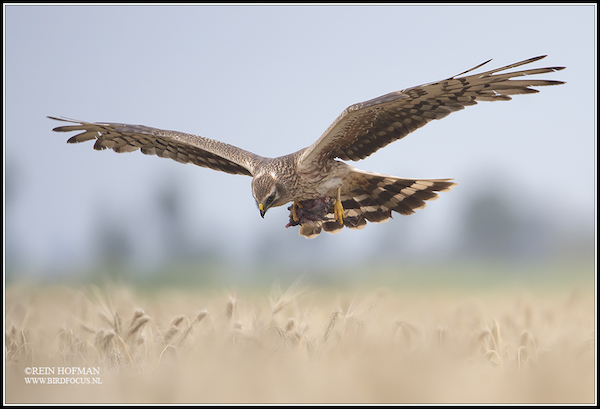
This blog is based closely on a press release from the Dutch Montagu’s Harrier Foundation with a few additions, omissions and slight changes of wording. I am very grateful to them all, particularly Ben Koks and Oike Vlaanderen, for the opportunity to bring this exciting news (and a good news story about harriers) to you. Many thanks too to the photographers for their images of these beautiful birds which have surprised us all by their breeding so far out of their normal range.
I wonder what will happen next year? the experience with lowland nesting Hen Harriers in England is that successful breeding in a lowland site one year is not a very good predictor of the birds returning to anywhere in the neighbourhood next year. Maybe next year it will be the UK? Or maybe it’s a complete one-off?
The Dutch Montagu’s Harrier Foundation describe this event as ‘One of the most magic events in ornithology that happened in our part of Europe during the last decades!‘ – quite right!
And to end, two images of food passes – the first of these Dutch Pallid Harriers and the second of Hen Harriers in the UK.
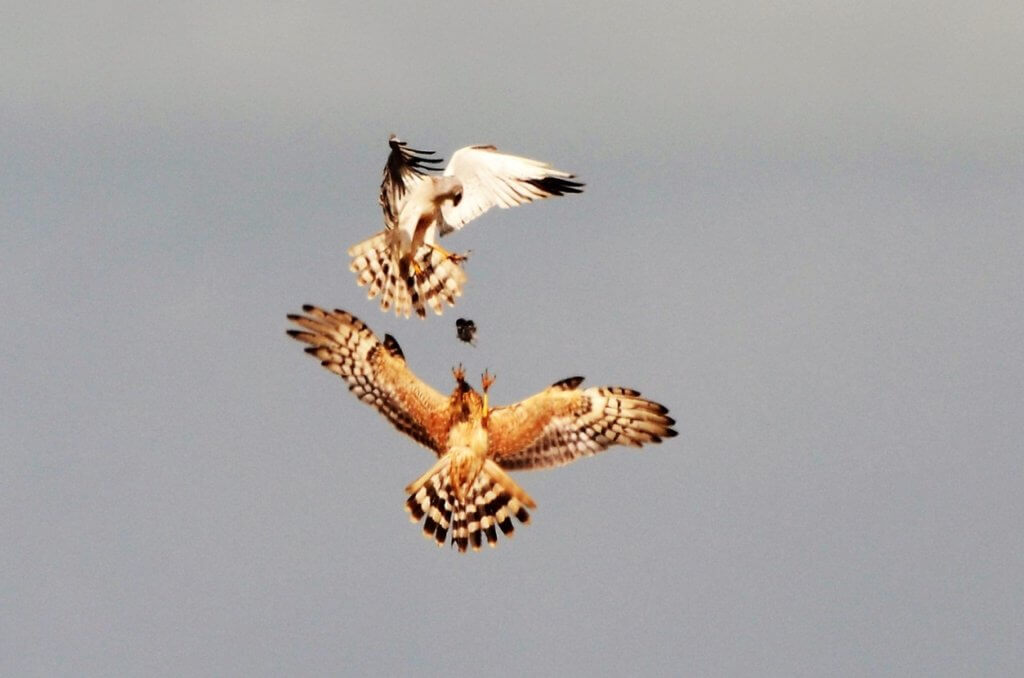
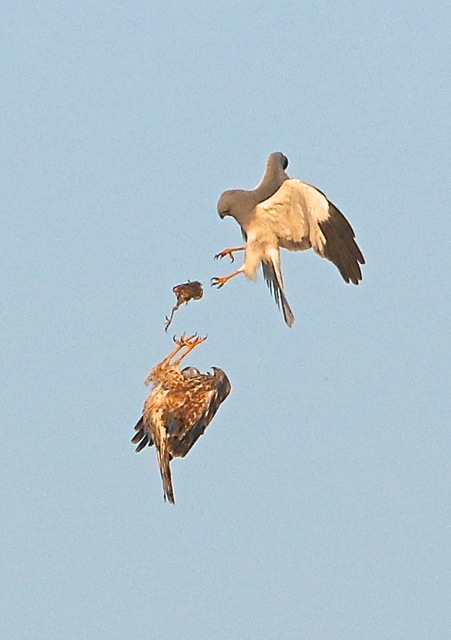
Excellent news which mirrors an apparent expansion westwards. Reports of Pallid Harriers in Spain have increased hugely in recent years (see –
http://www.rarebirdalert.co.uk/v2/Content/Pallid_Harrier_influx_in_NE_Iberia_in_March_2015.aspx?s_id=448153747). Its status there has changed from that of a rare vagrant to a regular, if still rare, winter visitor and passage migrant. I also recall (but can’t find the relevant reference) that breeding by a mixed pair of Pallid/Montagu’s Harriers has been suspected in the recent past.
Absolutely fantastic, now I’d be happy some of my taxes supported farmers in UK rearing these birds instead of commercial crops:) Imagine the car park revenue receipts from a season of people visiting such an event ….
Can anyone shed light on the fate or further sightings of the Dunsop Bridge male Pallid of May this year?
See http://raptorpolitics.org.uk/2017/05/11/forest-of-bowland-the-flight-of-a-pallid-harrier-during-a-setting-sun/
We can dream of breeding here in UK but what odds would the bookies give us on any bird surviving let alone successfully fledging young?
nimby – Pallids would survive if they chose a wheat field in Susses, say – they’d be playing Russian roulette (with more than half the chambers filled?) if they attempted on grouse moors.
Yep, happy with subsidised wheat fields Mark. The problem I have is landowner welfare payments and declining raptor numbers in the uplands. Time there were conditions attached to welfare receipts?
Excellent news, especially at a time when raptors of all sorts seem under such sustained attack here.
“interestingly, a male Pallid Harrier spent some time in Hen Harrier nesting habitat in the Forest of Bowland, Lancashire, UK, in late April/early May this year before ‘disappearing’ – as harriers often do in those parts – but I don’t think we have any solid evidence as to what happened to that bird.”
This, copied from above, is of particular relevance if anyone has hope of breeding in Britain. Until we can stop the illegal persecution, that is so widespread, I think we can kiss goodbye to hope!
Pessimistic I know, but I do feel, that’s realistic!
Mark W – it’s interesting that the Dutch birds nested in a cereal field whereas to get to Boewland the Pallid Harrier would have to flyover hundreds of cereal fields. Not sure what’s going on really.
Harriers and Short eared Owls can ‘smell’ a ‘Vole year’ so will fly a great distance to feed in that area. As suggested in a recent article many of these birds feeding and breeding in Britain can/may be of European origin as the Pallid showed at Bowland.
One of the problems lie in the fact that so many ground predators are removed from Red Grouse moors that ‘Vole Years’ are more likely and encourage these species to try their luck there only to find a gun pointed at them. The recent removal of Mountain Hares would have the same effect causing the voles to explode.
Was at Conil de La Frontera earlier this year peak migration time hundreds,of nightingale Groton vultures,booted and s.make eagles, an imperial eagle bestowing young, lesser westerly Montague, marsh and then barriers, little owls, little bustards, collared particles, all the histamines, spoonbills, parks three kinds, etc, etc all in one day with a brilliant guide Manuel, why do the British not care about such fabulous birds?
“Why do the British not care about such fabulous birds?” I do, and many, many others do too. Arguably, since the membership of the RSPB is far higher than the SEO, more Brits are keen on them than are Spaniards. Unfortunately, as recent incidents of persecution of Bearded Vultures, Spanish Imperial Eagles, etc in Spain illustrate, not all Spaniards share this love either. Glad, though you had a good time around Conil, which I know well and I do hope you didn’t miss the local Black-winged Kites!
Definitely a great story!
Please note the following breeding records from Germany (always mirroring years/periods of invasive occurrence):
1) ca. 1850 at Köchingen 10 km WSW of Brunswick (Blasius, Ber. 14. Vers. DO-G 1862, 42; Jb. Ver. Naturw. Braunschweig 5 1887 etc.
2) ca. 1853 Surenburg near Riesenbeck/Kr. Tecklenburg (Altum, J. Orn., 11 1863, p112
3) 1901 four juveniles at Erdinger Moos near Ismaning, Bavaria (Parrot, Jb. Orn. Ver. München 3, 1903)
4) 1950 island of Norderney, Lower Saxony. 10.07. a fledgling caught. (Goethe & Ringleben J. Orn. 94, 1953, p347
For additional hints see Glutz et al. 1971: Handbuch der Vögel Mitteleuropas Band 4.
Ralf – welcome and thanks v much for that info.
Optimistic and frank report. Any lessons Mark from the NL for the UK, esp England (especially ‘to prevent the young from being killed by the combine harvester’ or being persecuted here)?
Third visit to Langholm where HH criss-cross the public road over the moor – 50 sec update here https://twitter.com/blackgull/status/877520517158363137
best